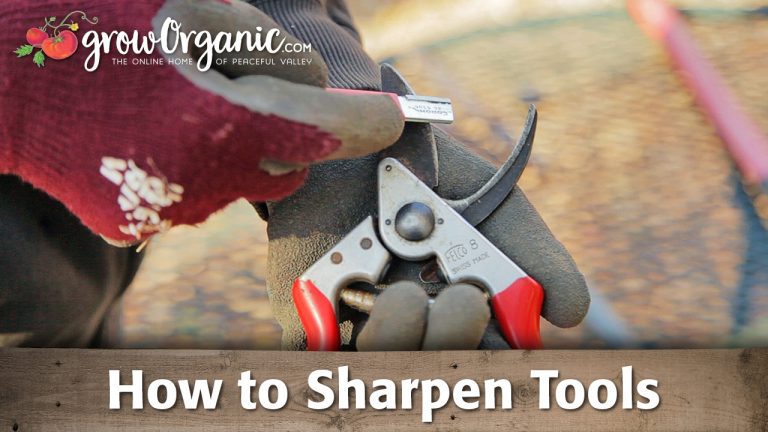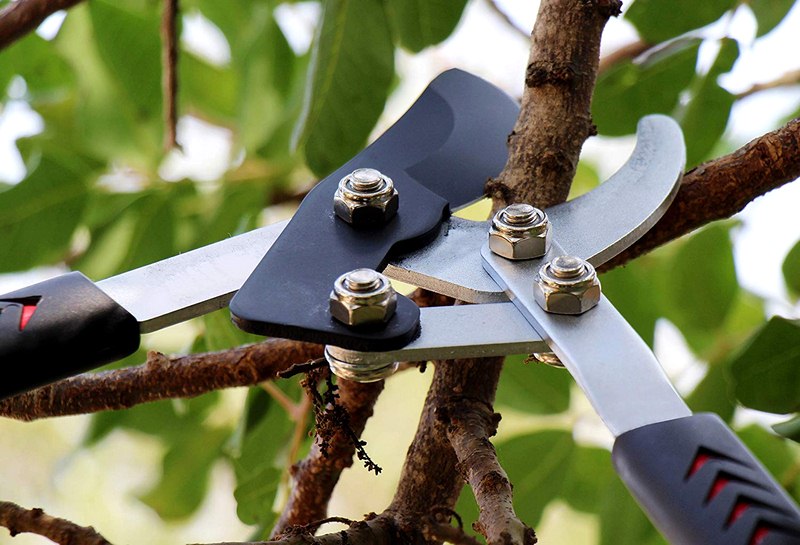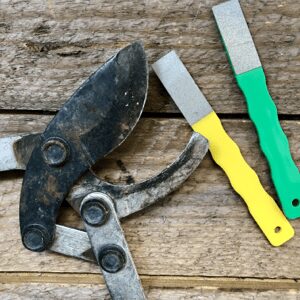Choosing the Right Sharpening Tools for Your Garden Loppers
When it comes to sharpening garden loppers, having the right tools is essential. There are several types of sharpening tools available, each with its own unique characteristics and benefits. Whetstones, diamond stones, and sharpening steels are among the most popular options.
Whetstones are a popular choice for sharpening garden loppers due to their versatility and effectiveness. They are available in various grits, ranging from coarse to fine, allowing for a range of sharpening options. Whetstones are also relatively inexpensive and easy to use, making them a great option for those new to sharpening.
Diamond stones, on the other hand, are a more aggressive option, ideal for sharpening heavily dulled or damaged blades. They are made with diamond-coated surfaces that quickly remove metal and restore the blade’s edge. Diamond stones are more expensive than whetstones but offer faster results and longer-lasting sharpness.
Sharpening steels, also known as honing steels, are designed for fine-tuning and maintaining already-sharp blades. They are typically made of ceramic or steel and feature a series of small, evenly spaced grooves that help realign the blade’s edge. Sharpening steels are perfect for regular maintenance and can help extend the life of your garden loppers.
When selecting a sharpening tool, consider the type of garden loppers you have, the level of dullness, and your personal preference. It’s also essential to read reviews and follow the manufacturer’s instructions for the best results. By choosing the right sharpening tool, you’ll be able to achieve a razor-sharp edge and enjoy improved performance from your garden loppers.
Preparing Your Garden Loppers for Sharpening
Before sharpening your garden loppers, it’s essential to prepare them properly to ensure a safe and effective sharpening process. This step is often overlooked, but it’s crucial in achieving the best results. In this section, we’ll guide you through the steps to prepare your garden loppers for sharpening.
Step 1: Clean the Blades
Start by cleaning the blades of your garden loppers to remove any dirt, debris, or sap that may be accumulated. Use a soft-bristled brush or a cloth to wipe down the blades, paying particular attention to the areas where the blades meet the handles. This will help prevent any debris from interfering with the sharpening process.
Step 2: Remove Any Debris
Inspect the blades for any debris, such as twigs or leaves, that may be stuck between the blades or in the pivot point. Use a small screwdriver or a pair of tweezers to gently remove any debris you find. This will help ensure that the blades are able to move freely and that the sharpening process is not hindered.
Step 3: Inspect for Damage
Inspect the blades for any signs of damage, such as nicks, cracks, or rust. If you find any damage, it’s best to address it before sharpening the blades. Use a file or a whetstone to smooth out any nicks or cracks, and apply a rust-inhibiting coating to any rusty areas.
Step 4: Lubricate the Pivot Point
Finally, lubricate the pivot point of your garden loppers to ensure that the blades are able to move freely. Use a small amount of oil or silicone spray to lubricate the pivot point, and wipe off any excess with a cloth.
By following these steps, you’ll be able to prepare your garden loppers for sharpening and ensure a safe and effective sharpening process. In the next section, we’ll guide you through the steps to sharpen your garden loppers using the chosen sharpening tool.
Sharpening Your Garden Loppers: A Step-by-Step Guide
Now that you have prepared your garden loppers for sharpening, it’s time to start the sharpening process. In this section, we will guide you through the steps to sharpen your garden loppers using the chosen sharpening tool.
Step 1: Position the Loppers
Place the garden loppers on a stable surface, with the blades facing upwards. Make sure the loppers are secure and won’t move around during the sharpening process.
Step 2: Choose the Correct Angle
The angle at which you sharpen the blades is crucial. For most garden loppers, a 20-30 degree angle is recommended. You can use a sharpening guide or a protractor to ensure the correct angle.
Step 3: Start Sharpening
Hold the sharpening tool at the chosen angle and start sharpening the blades. Use light strokes, moving the tool from the heel of the blade to the tip. Apply gentle pressure, increasing it as needed.
Step 4: Check Progress
After a few strokes, inspect the blades to check progress. You should start to see a sharp edge forming. If not, adjust the angle or apply more pressure.
Step 5: Repeat the Process
Continue sharpening the blades, repeating the process until you achieve the desired level of sharpness. Be careful not to over-sharpen, as this can damage the blades.
Step 6: Final Check
Once you have completed the sharpening process, inspect the blades one last time to ensure they are sharp and even. If necessary, make any final adjustments.
By following these steps, you should be able to sharpen your garden loppers effectively. Remember to always use caution when handling sharp objects and to maintain your loppers regularly to keep them in top condition.
Tips for Maintaining Your Newly Sharpened Garden Loppers
Now that you have successfully sharpened your garden loppers, it’s essential to maintain them to keep them in top condition. Regular maintenance will help extend the life of your loppers and ensure they continue to perform optimally.
Regular Cleaning
After each use, clean your garden loppers with a soft-bristled brush or a cloth to remove any debris or sap. This will help prevent rust and corrosion, and keep the blades in good condition.
Storage
Store your garden loppers in a dry, secure location, away from direct sunlight and moisture. This will help prevent rust and corrosion, and keep the blades in good condition.
Maintenance Schedules
Establish a regular maintenance schedule to keep your garden loppers in top condition. This can include weekly cleaning, monthly sharpening, and annual inspection and maintenance.
Inspection and Maintenance
Regularly inspect your garden loppers for any signs of wear or damage. Check the blades for nicks, cracks, or rust, and the handles for any signs of damage or wear. Make any necessary repairs or replacements to keep your loppers in good condition.
By following these tips, you can keep your garden loppers in top condition and ensure they continue to perform optimally. Remember, regular maintenance is key to extending the life of your loppers and keeping them in good condition.
Common Mistakes to Avoid When Sharpening Garden Loppers
Sharpening garden loppers can be a straightforward process, but there are some common mistakes to avoid to ensure you get the best results. In this section, we’ll discuss some of the most common mistakes people make when sharpening garden loppers and provide tips on how to avoid them.
Using the Wrong Sharpening Tool
One of the most common mistakes people make when sharpening garden loppers is using the wrong sharpening tool. Different types of sharpening tools are designed for specific types of blades, so it’s essential to choose the right tool for your garden loppers. For example, a whetstone is ideal for sharpening straight-edged blades, while a diamond stone is better suited for sharpening curved or serrated blades.
Applying Too Much Pressure
Applying too much pressure when sharpening garden loppers can damage the blades and make them more difficult to sharpen. It’s essential to apply gentle pressure and use light strokes to avoid damaging the blades. Start with light pressure and gradually increase it as needed.
Neglecting to Maintain the Blades
Neglecting to maintain the blades of your garden loppers can lead to a dull edge and reduced performance. Regularly cleaning and inspecting the blades can help prevent this and ensure your garden loppers continue to perform optimally.
Not Sharpening the Blades Regularly
Not sharpening the blades of your garden loppers regularly can lead to a dull edge and reduced performance. Regular sharpening can help maintain the edge and ensure your garden loppers continue to perform optimally.
By avoiding these common mistakes, you can ensure your garden loppers are always in top condition and perform optimally. Remember to always use the right sharpening tool, apply gentle pressure, and maintain the blades regularly to get the best results.
Sharpening Garden Loppers: Safety Precautions to Keep in Mind
Sharpening garden loppers can be a safe and effective way to maintain your pruning tools, but it’s essential to take some basic safety precautions to avoid accidents. In this section, we’ll discuss some of the most important safety precautions to keep in mind when sharpening garden loppers.
Wearing Protective Gear
When sharpening garden loppers, it’s essential to wear protective gear to prevent injury. This includes safety glasses, gloves, and a dust mask. Safety glasses will protect your eyes from flying debris, while gloves will prevent cuts and abrasions. A dust mask will prevent you from inhaling dust and debris.
Working in a Well-Lit Area
It’s essential to work in a well-lit area when sharpening garden loppers to ensure you can see what you’re doing. A well-lit area will also help you spot any potential hazards, such as loose debris or uneven surfaces.
Keeping Children and Pets Away
Sharpening garden loppers can be a hazardous activity, especially for children and pets. It’s essential to keep them away from the area where you’re sharpening to prevent accidents.
Using the Right Sharpening Tool
Using the right sharpening tool is essential for safe and effective sharpening. Choose a sharpening tool that’s designed for your garden loppers, and follow the manufacturer’s instructions for use.
By following these safety precautions, you can ensure a safe and effective sharpening experience. Remember to always prioritize safety when working with sharp objects, and take the necessary precautions to prevent accidents.
Conclusion: Enjoy Your Newly Sharpened Garden Loppers
Congratulations You have now successfully sharpened your garden loppers and are ready to put your newfound skills to the test. By following the steps outlined in this article, you have learned how to sharpen your garden loppers and maintain them to keep them in top condition.
Remember, sharp garden loppers are essential for any gardening task, and by keeping them sharp, you will be able to prune and cut with ease and precision. Whether you are a seasoned gardener or just starting out, sharp garden loppers will make all the difference in your gardening experience.
As a final tip, we recommend that you regularly inspect and maintain your garden loppers to ensure they remain in top condition. This will not only extend the life of your loppers but also ensure that they continue to perform optimally.
By following the tips and guidelines outlined in this article, you will be able to enjoy your newly sharpened garden loppers and take your gardening skills to the next level. Happy gardening!
Conclusion: Enjoy Your Newly Sharpened Garden Loppers
Congratulations You have now completed the step-by-step guide on how to sharpen garden loppers. By following the instructions and tips outlined in this article, you should be able to sharpen your garden loppers with ease and confidence.
Remember, sharp garden loppers are essential for any gardening task, and by keeping them sharp, you will be able to prune and cut with precision and accuracy. Whether you are a seasoned gardener or just starting out, sharp garden loppers will make all the difference in your gardening experience.
As a final tip, we recommend that you regularly inspect and maintain your garden loppers to ensure they remain in top condition. This will not only extend the life of your loppers but also ensure that they continue to perform optimally.
By following the tips and guidelines outlined in this article, you will be able to enjoy your newly sharpened garden loppers and take your gardening skills to the next level. Happy gardening!
And don’t forget, with your newly sharpened garden loppers, you’ll be able to tackle even the toughest gardening tasks with ease. So go ahead, get out there and start pruning, cutting, and shaping your garden with precision and confidence.









